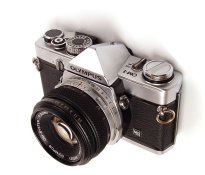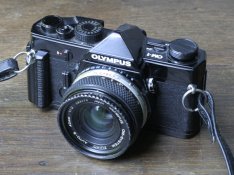TheToadMen
Subscriber
Hi,
I'm a Nikon camera user for 135 format for several years now. I never used Canon or Olympus. My first camera was a used Nikon EL2, given to me by my aunt when I was 18 (about 39 years ago) so I sticked to Nikon.
But I know GAS sometimes and I want to know what other cameras are about. So I go me a Canon AE-1 last year with 2 lenses ($25) and a Canon T70 ($20) with a 50 mm lens recently to toy around. I always had in mind to get me an Olympus to see what that is about. I heard good things about Olympus and use a very good Olympus Mju II as a point and shoot camera.
Today a fellow at the photo club was selling/giving away some old gear for a friend. So I got me a Olympus OM-1 with 50 mm f/1,8 F.Zuiko Auto-s, a Panagor Auto Wide Angle 28 mm f/2.5 and a Panagor Auto Tele 135 mm f/2.8 and a camera case for only $13.
The camera has a big ding on the right corner of the top/back and the prism glass has some edge separation. But the camera seems to work properly, so it will be a nice camera to use an Olympus for just a few bucks to me. I don't need autofocus, I like prime lenses and a light meter in a SLR is nice too.
What I wanted to ask is: what is Olympus about? And is this the right model and lens to use (in general) from Olympus from this aera or the OM-series?
Thanks,
Bert from Holland
I'm a Nikon camera user for 135 format for several years now. I never used Canon or Olympus. My first camera was a used Nikon EL2, given to me by my aunt when I was 18 (about 39 years ago) so I sticked to Nikon.
But I know GAS sometimes and I want to know what other cameras are about. So I go me a Canon AE-1 last year with 2 lenses ($25) and a Canon T70 ($20) with a 50 mm lens recently to toy around. I always had in mind to get me an Olympus to see what that is about. I heard good things about Olympus and use a very good Olympus Mju II as a point and shoot camera.
Today a fellow at the photo club was selling/giving away some old gear for a friend. So I got me a Olympus OM-1 with 50 mm f/1,8 F.Zuiko Auto-s, a Panagor Auto Wide Angle 28 mm f/2.5 and a Panagor Auto Tele 135 mm f/2.8 and a camera case for only $13.
The camera has a big ding on the right corner of the top/back and the prism glass has some edge separation. But the camera seems to work properly, so it will be a nice camera to use an Olympus for just a few bucks to me. I don't need autofocus, I like prime lenses and a light meter in a SLR is nice too.
What I wanted to ask is: what is Olympus about? And is this the right model and lens to use (in general) from Olympus from this aera or the OM-series?
Thanks,
Bert from Holland













 ) to accept the small grip for the OM4Ti (and OM3Ti), which makes a lot of difference.
) to accept the small grip for the OM4Ti (and OM3Ti), which makes a lot of difference. 


